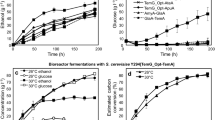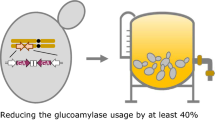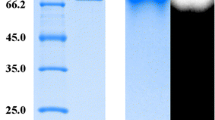Abstract
A recombinant strain of Saccharomyces cerevisiae was constructed that contained the genes encoding a bacterial α-amylase (AMY1), a yeast glucoamylase (STA2) and a bacterial pullulanase (pulA). The Bacillus amyloliquefaciens α-amylase and S. cerevisiae var. diastaticus glucoamylase genes were expressed in S. cerevisiae using their native promoters and the encoded enzymes secreted under direction of their native leader sequences. In contrast, the Klebsiella pneumoniae pullulanase gene was placed under the control of the yeast alcohol dehydrogenase gene promoter (ADC1 P ) and secreted using the yeast mating pheromone α-factor secretion signal (MFα1 S ). Transcription termination of the pullulanase gene was affected by the yeast tryptophan synthase gene terminator (TRP5 T), whereas termination of the glucoamylase and α-amylase genes was directed by their native terminators. Pullulanase (PUL1) produced by recombinant yeasts containing ADC1 P MFα1 S pulA TRP5T (designated PUL1) was further characterized and compared to its bacterial counterpart (PulA). The different genes were introduced into S. cerevisiae in different combinations and the various amylolytic Saccharomyces transformants compared to Schwanniomyces occidentalis. Introduction of PUL1 into a S. cerevisiae strain containing both STA2 and AMY1, resulted in 99% assimilation of starch
Similar content being viewed by others
References
Bender H, Wallenfels K (1961) Untersuchungen an pullulan. II. Spezifischer abbau durch ein bacterielles enzym. Biochem Z 334:79–95
Bender H, Wallenfels K (1966) Pullulanase (an amylopectin and glycogen debranching enzyme) from Aerobacter aerogenes. Methods Enzymol 8:555–559
Bollag DM, Edelstein SJ (1991) Protein methods. J Wiley, New York
Carle GF, Olson MV (1985) An electrophoretic karyotype for yeast. Proc Natl Acad Sci USA 82:3756–3760
Charalambous BM, Keen JN, McPherson MJ (1988) Collagen-like sequences stabilize homotrimers of a bacterial hydrolase. EMBO J 7:2903–2909
De Mot R, Andries K, Verachtert H (1984) Comparative study of starch degradation and amylase production by ascomycetous yeast species. System Appl Microbiol 5:106–118
Dhwale MR, Ingledew WM (1986) Starch hydrolysis by depressed mutants of Schwanniomyces castellii. Biotechnol Lett 5:185–190
Dziezak JD (1987) Yeasts and yeast derivatives: definitions, characteristics and processing. Food Technol 104–121
Filho SA, Galembeck EV, Faria JB, Schenberg Frascino AC (1986) Stable yeast transformants that secrete functional α-amylase encoded by cloned mouse pancreatic cDNA. Biotechnology 4:311–315
Fogarty WM, Kelly CT (1980) Amylases, amyloglucosidases and related glucanases. In: Rose AH (ed) Microbial enzymes and bioconversions. Academic Press, New York, pp 115–170
Fujiyama A, Tamanoi F (1986) Processing and fatty acid acylation of RAS1 and RAS2 proteins in Saccharomyces cerevisiae. Proc Natl Acad Sci USA 83:1266–1270
Hunter JJ, Visser JH, De Villiers OT (1991) Preparation of grapes and extraction of sugars and organic acids for determination by high performance liquid chromatography. Am J Enol Vitic 42:237–244
Ito H, Fukuda Y, Murata K, Kimura A (1983) Transformation of intact yeast cells treated with alkali cations. J Bacteriol 153:163–168
Janse BJH, Pretorius IS (1993) Expression of the Klebsiella pneumoniae pullulanase-encoding gene in Saccharomyces cerevisiae. Curr Genet 24:32–37
Janse BJH, Steyn AJC, Pretorius IS (1993) Regional sequence homologies in starch-degrading enzymes. Curr Genet 24:400–407
Jensen BF, Norman B (1984) Bacillus acidopullulyticus: application and regulatory aspects for use in food industry. Process Biochem 19:129–134
Manners DJ (1989) Recent developments in our undestanding of amylopectin structure. Carbohydr Pol 11:87–112
McCann AK, Barnett JA (1986) The utilization of starch by yeasts. Yeast 2:109–115
Mercier C, Frantz BM, Whelan WJ (1972) An improved purification of cell-bound pullulanase from Aerobacter aerogenes. Eur J Biochem 26:1–9
Modena D, Vanoni M, Englard S, Marmur J (1986) Biochemical and immunological characterization of the STA2—encoded extracellular glucoamylase from Saccharomyces diastaticus. Arch Bioch Biophys 248:138–150
Nunberg JH, Meade JH, Cole G, Lawyer FC, McCabe P, Schweickart B, Tal R, Wittman VP, Flatgaard JE, Innis MA (1984) Molecular cloning and characterization of the glucoamylase gene of Aspergillus awamori. Mol Cell Biol 4:2306–2315
Pretorius IS, Marmur J (1988) Localization of yeast glucoamylase genes by PFGE and OFAGE. Curr Genet 14:9–13
Pretorius IS, Chow T, Marmur J (1986) Identification and physical characterization of yeast glucoamylase genes. Mol Gen Genet 203:36–41
Pretorius IS, Laing E, Pretorius GHJ, Marmur J (1988) Expression of a Bacillus α-amylase gene in yeast. Curr Genet 14:1–8
Pugsley AP, Chapon C, Schwartz M (1986) Extracellular pullulanase of Klebsiella pneumoniae is a lipoprotein. J Bacteriol 166:1083–1088
Rosales FH (1984) Yeast as protein source for human nutrition. Acta Microbiol Hung 31:159–172
Sambrook J, Fritsch EF, Maniatis T (1989) Molecular cloning. A laboratory manual, 2nd edn. Cold Spring Harbor Laboratory Press, Cold Spring Harbor, New York
Simoés-Mendes B (1984) Purification and characterization of the extracellular amylases of the yeast Schwanniomyces alluvius. Can J Microbiol 30:1163–1170
Solomon B (1978) Starch hydrolysis by immobilized enzymes, industrial applications. In: Ghose TK, Fiecther A, Blaketbrough N (eds) Advances in biochemical engineering. Springer Berlin Heidelberg New York, pp 135–177
Steyn AJC, Pretorius IS (1991) Co-expression of a Saccharomyces diastaticus glucoamylase gene and a Bacillus amyloliquefaciens α-amylase gene in Saccharomyces cerevisiae. Gene 100:85–93
Van der Westhuizen TJ, Pretorius IS (1992) The value of electrophoretic fingerprinting and karyotyping in wine yeast breeding programmes. Antoine van Leeuwenhoek 61:249–257
Wankhede DB, Ramteke RS (1982) Synergistic digestibility of several native starches by amylolytic enzymes. Stärke 34:309–312
Wilson JJ, Ingledew WM (1982) Isolation and characterization of Schwanniomyces alluvius amylolytic enzymes. Appl Environ Microbiol 44:301–307
Wilson JJ, Khachatourians GG, Ingledew WM (1982) Schwanniomyces: SCP and ethanol from starch. Biotechnol Lett 4:333–338
Zobel HF (1988) Molecules to granules: a comprehensive starch review. Stärke 40:44–50
Author information
Authors and Affiliations
Rights and permissions
About this article
Cite this article
Janse, B.J.H., Pretorius, I.S. One-step enzymatic hydrolysis of starch using a recombinant strain of Saccharomyces cerevisiae producing α-amylase, glucoamylase and pullulanase. Appl Microbiol Biotechnol 42, 878–883 (1995). https://doi.org/10.1007/BF00191185
Received:
Revised:
Accepted:
Issue Date:
DOI: https://doi.org/10.1007/BF00191185




